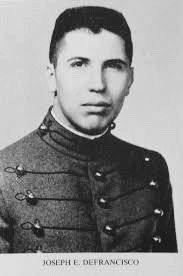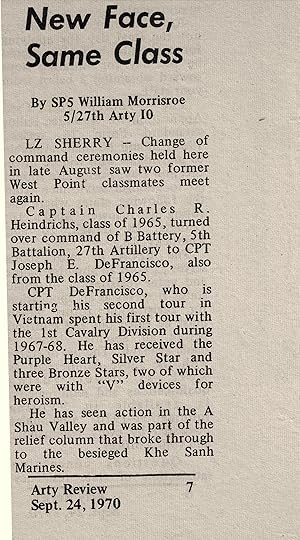Joseph DeFrancisco – Battery Commander – Part One
Captain Joseph DeFrancisco took command of B Battery from Captain Chuck Heindrichs, a West Point classmate, in August of 1970 . The next month this article appeared in the Artillery Review.
West Point
I grew up in an era in which most of the adult male members of my family had been in World War II. That was a defining moment for those folks and they talked about it. I wouldn’t say they dwelt on it, but there was ample conversation about their experiences in World War II. And then growing up, born in ’42, I started going to movies in the early ‘50s and there was just a plethora or World War II movies. To serve your country, at least in my community and in my mind, was a very noble thing. I grew up surrounded by those sorts of ideals and those sorts of influences. None of my relatives had ever gone to West Point. In fact very few of them had gone to college, so West Point was the epitome if you were going into the military.
I was living in Albany, New York, which is only two hours north of West Point, when the opportunity became available. I decided to try for it, and went to West Point. And that began my career. I went into the Academy in 1961 and I left active duty in 1998. My whole adult life was devoted to service to the country.
I entered West Point in the middle of the cold war and only six years away from the Korean experience. I did not know anything about the Army, and of course during my four years at West Point I did not learn a great deal about the Army either because I only saw one little piece of it. When I graduated I selected the field artillery branch because the instructors I admired most were field artillerymen. And most of the experiences I had in visiting other installations – and we visited a lot, to include the homes of all the branches – I was most impressed with artillery. That’s how I selected field artillery: not very scientific, but that’s the way it all began.
 Cadet Joseph E. DeFranciso
Cadet Joseph E. DeFranciso
Remember Field Artillery was not a separate branch back then. The branch was Artillery, made up of Field Artillery and Air Defense Artillery (ADA encompassed the Dusters with their twin 40mm cannons, Quad-50 machine guns, and searchlights). An officer was expected to be able to go to field artillery or ADA. My preference was always for the howitzers of field artillery.
Germany
Out of West Point it was mandatory that we attend Ranger school. Vietnam was starting, so the powers said, OK, we’re going to have all you Regular Army commissioned officers go to Ranger school. Unfortunately we were not authorized to go to the officer basic course in artillery. The idea was you’d pick up what you needed to know about artillery when you got to your unit.
After Ranger school I also went to airborne school, got married, and went off to my first assignment in Germany, to a field artillery battalion.
I got to Germany New Years Eve of 1965. I was astounded at the low level of the quality of training and the character of the leadership. It was far below what I expected. It may have been a function of the unit I was in, I did not know. It was a Corps artillery battalion, not assigned to a Division, that also might have made a difference. There were very few high quality officers or NCOs.
There were a lot of officers in that battalion who were reservists, called to active duty for the most recent Berlin crisis and then decided to stay. In those days – I don’t want to say bad things about the reserves because now Army Reserves and National Guard are an integral part of the Army’s operational force – but in those days there was a huge quality difference between the reserves and active duty.
When I arrived the battalion was full; they did not even have a slot for me, so they made me a commo officer. Three months later I was acting battery commander, because the battalion had been denuded of officers due to the dramatic ramp up in Vietnam.
At that point we were down to five officers. You can imagine the level and quality of leadership, and everything that goes with that. Two of my senior NCOs and one of my superior commanders were alcoholics. Sergeants went around sucking those candies filled with liquor. It was awful.
This assignment was supposed to be for three years, but luckily I was there for a brief period, only four months. Because of Vietnam the Army decided to pull two thousand artillery lieutenants out of Germany to populate the basic training centers opening across the United States.
I went to Ft. Bragg and became a basic training officer, teaching subjects such as marksmanship, customs and courtesy of the service, military law, the basic implications of the Uniform Code of Military Justice, drill and ceremony: all those things that are necessary for discipline and cohesion in the unit. I did that for nine months.
First Vietnam Tour – A Heavy Year
I went to Vietnam a field artillery first lieutenant in June of 1967, well before my time at LZ Sherry (August 1970). I spent my entire tour, a full year, with the First Cavalry Division. I joined the 1st battalion of the 21st Artillery at An Khe and went immediately up around the Kontum/ Pleiku area, which is in the highlands in the far western part of South Vietnam. After spending about five months in the battalion headquarters I was reassigned as the Artillery Liaison Officer to 2nd/7th Cavalry. It was during that time that I saw some pretty serious fighting and I got into some pretty heavy stuff with the First Cav, all a part of the TET Counter Offensive. There was the Battle of Hue. Then there was the relief of Khe Sanh, and then shortly thereafter was the incursion into the A Shau Valley. During those times I lived, worked, slept, ate, and fought with the infantry all the time. I rarely saw my artillery battalion commander, I never saw my battalion headquarters. I was with the infantry all the time.
My first job brand new in country was headquarters battery commander, a tough and thankless job. You’re basically the housekeeper. I remember my First Sergeant, a wonderful man. He helped me a great deal to keep things in perspective, and was a great help on the convoys we had to run. Our longest convoy I lead was from the Pleiku area in the western part of the Central Highlands to the Bong Son Plain on the coast of the South China Sea. I had just read Street Without Joy before going over to Vietnam. The book includes the story of a very famous ambush on Highway 19, the east-west highway across the central highlands through the Yang Mang Pass, where the Viet Minh wiped out an entire French column. My convoy went right through there.
See George Buck’s stories – who was a Duster platoon leader in that area about the same time and also ended up at Sherry, but before Joe’s time.
I went over there to fight, very young and idealistic, and all of a sudden I’m at a headquarters battery. This was not what I want to do so I volunteered to be an aerial observer and a forward observer, every now and then going out with South Vietnamese units. I spent a great deal of time learning how to adjust artillery and call in fire commands. Remember there was no artillery basic course so this was my first time learning all this. As an aerial observer I literally learned artillery on the fly.
Then I became the fire support officer, then called Artillery LNO, for the 2nd/7th Cav and that’s where I learned fire support coordination. I was responsible for all the fire planning, preparations for troops coming into LZs, and maintenance of defensive targets for various LZs and base camps.
During what was called the TET ’68 Counter Offensive we moved up to Camp Evans in the central highlands in the center of Vietnam. Evans was the 1st Cav’s Division headquarters fifteen miles north west of Hue. We flew out of there to go into the area just outside of Hue, then to relieve the Marines under siege at Khe Sanh to our west at the northern end of the A Shau Valley, and eventually to support the A Shau Valley incursion.
Hue
At the beginning of the TET Offensive in the early morning hours of January 31, 1968, a division-sized force of North Vietnamese and Vietcong soldiers launched a coordinated attack on the city of Hue. It would be one of the longest and bloodiest battles of the Vietnam War lasting almost a month. The North Vietnamese and Viet Cong lost 13,246 killed. South Vietnamese killed: 452. U.S. killed: 216.
Did some fighting around Hue after TET of ’68. I was never in Hue City itself. Instead the 2nd/7th Cav and other elements of the 1st Cav’s 3rd Brigade conducted operations around the periphery of the city. We did get into some heavy contact. At one point the fighting became so intense that some of our direct support units ran out of 105mm ammunition. At least one FO had to use naval gun fire from the battleship New Jersey, which was off-shore near Hue, to support ground operations. As any FO will tell you, this not an ideal situation given the range dispersion of naval guns.




